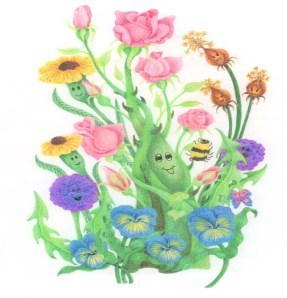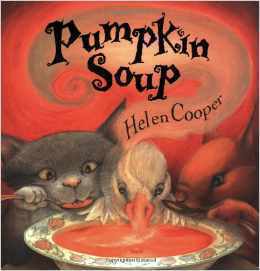Bonnie Ferrante's Blog, page 98
May 11, 2014
Ray, Jane. The Apple-pip Princess. Book Review.
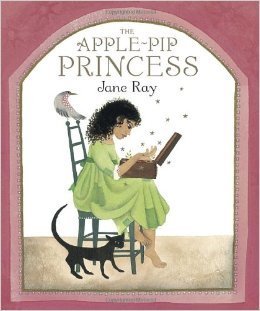
This lovely story follows the traditional fairy tale format, but with a twist. Since the Queen’s death, the land has become stark and the people sad. The king, who is getting old, decides to choose one of his three daughters to reign in his place after his passing. To win his approval, a daughter must do something to make him proud within a week. The first two daughters are egotistical and in their pursuit of fame they cause even more suffering for the people. The third daughter, whose name is Serenity, chooses a gentle more giving approach. In her success, the land returns to fertility and happiness.
The fact that Jane Ray chooses girls to tell this story of three children in competition for the crown gives an interesting twist to a traditional framework. She also chooses to use people of color. I was pleased to see that it was not an act of courage or daring that won the crown. Instead, behaving as a benevolent and peaceful ruler was the best choice. The heroine is “shy and quiet and ordinary.”
The illustrations have fanciful elements in the buildings, metal works, plants, clothing, and articles in Serenity’s special box of her mother’s keepsakes. The illustrations of the two towers are particularly detailed. Her pictures, especially the two page spreads, vividly portray this and the uniqueness of the kingdom. She has a lovely way of framing the text on several pages.
The story would be an excellent addition to any teacher’s unit on fairytales. It lends itself well to discussions on values and is especially relevant to popular culture’s pursuit of ostentatious possessions and self-indulgence.
Highly recommended.


May 9, 2014
Temperley, Howard – In the Days of Dinosaurs, A Rhyming Romp Through Dino History. Illustrations by Michael Kline
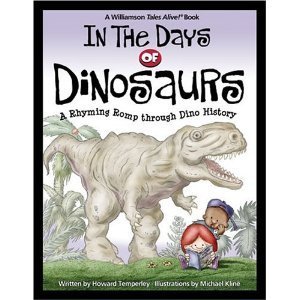
In the Days of Dinosaurs is a meaty book of 64 pages. Each page features a different dinosaur including pronunciation guide, information in rhyme, and a cartoonish drawing. A nonfiction rhyming book is rather unusual, but Temperley does an admirable job of portraying scads of information in verse. However, I did find the rhyming lines distracted from my understanding of the information. A child would read this book more for the entertainment value than for research. The end of the book has a helpful two-page spread the dinosaur timeline.
The illustrations push the book more toward the entertainment type. It has dinosaurs in a bed with a blanket and headboard, wearing a bib, and reading the sports page. The inclusion of humans interacting with dinosaurs may lead to more confusion for children interested in archaeology. Personally, I would’ve preferred realistic illustrations.
The author certainly gets across the magnificence, power, and unique qualities of dinosaurs. Because of illustrations, I would not use this book as a child’s first introduction to dinosaurs but it would be a lot of fun for kids who are familiar with these magnificent beasts and understands what they were really like.
Recommended with limitations.


May 7, 2014
Grinstead, Susan. Rosebush. Illustrated by Joan Thomas. Manuscript Critique.
When critiquing picture book manuscripts, I discuss only three issues, even if there are more that should be addressed. This author wanted to know why publishers were not responding positively to her submission.
Rosebush is a 14 page manuscript. Seven pages are illustration and seven pages are text. It is the story of a rosebush that suffers from bullying and low self-esteem. Her thorns harm others and she doesn’t produce blossoms the first year. This is resolved the second year, when she blooms however the issue of thorns is not really addressed.
Issue One
Beginning writers have to follow the rules. If you become a best-selling author, then you can write a 14 page picture book or a 37 page picture book and no one will care. But when you’re starting out, you have to carefully study the expectations of publishers. There are standard formats that must be followed. This site gives an example – http://taralazar.com/2009/02/22/picture-book-construction-know-your-layout/. A picture book writer needs to begin with a storyboard. Here, she plans what information will be revealed by the text and what will be revealed by the accompanying picture. The normal structure is 32 pages. Word count should be between 500 and 600 words. Anything close to 1000, and editors are quick to dismiss the manuscript. After reading the text, the story would be much improved if the word count for this 990 word book was reduced to 350 to 400 words. Each page of this book had over 100 words. The author said this book was written for children 5 to 8 years old. A single sentence to a single paragraph on each page is appropriate for that age level. While your book may be enjoyed by readers of many ages, it is well advised to write with a specific group in mind. If you are going to submit to a traditional publishing house, they want to have a clear target market. A strong edit is needed.
Issue Two
Picture books have a certain rhythm. The story is not structured the same way as a story in a magazine. A picture book is a lot like poetry. Every word must be powerful and essential. The stories generally follow a certain pattern that children find comfortable. The main character should have a problem to solve. Although the rosebush does grow the second year and produce flowers, the resolution seems passive and incomplete. There is too much narration and not enough dialogue, there is too much telling and not enough showing, and there are too many sentences where nothing is really happening. This site gives ideas on how to improve this. http://www.aaronshep.com/kidwriter/Tips.html
Issue Three
As a rule, publishers prefer to receive manuscripts that are not illustrated unless you are a professional illustrator. They often prefer to match a beginning writer with a well-established illustrator in order to give sales a boost. When you submit a fully illustrated book, you are doubling the chances of being rejected. Although the illustrations are quite lovely in Rosebush, they do little to expand the story. Illustrating a children’s book is much more than drawing a picture of what the words say.
In this book, we never see the humans. The prospective on each page is exactly the same. All the flowers are presented in isolated illustration. It has the feeling of a plant identification book. The pictures, and the words, need to be more dramatic. This site would be helpful to the illustrator. http://www.meghan-mccarthy.com/illustratorsguide.html
This story has potential but I would advise the writer and illustrator both to study the structure and presentation of dozens of successful picture books, read blogs and sites on picture book writing, purchase a few books on the subject, and perhaps take an online course. The most comprehensive and clearest book is Writing with Pictures: How to Write and Illustrate Children’s Books by Uri Shulevitz.


May 6, 2014
Cooper, Helen. Pumpkin Soup – Book Review
Cat, Squirrel, and Duck live together in an old white cabin beside a pumpkin patch. Cat plays the bagpipes. Squirrel plays the banjo. Duck sings.
Together they make pumpkin soup and are the best of friends, until the duck decides he wants to be the Head Cook. An argument ensues and Duck leaves. As the day drags on Cat and Squirrel worry about their friend and all the dangers he might be encountering. Futilely, they search everywhere for Duck. They decide that Duck has probably found some better friends. Upon returning home, they are delighted to find Duck has returned. They allow him to stir the soup, even though he makes an incredible mess.
Everyone is happy and calm until, Duck says, “I think I’ll play the bagpipes now.”
Children will relate well to this story. Conflict often comes when a friend decides to break free of his usual routine. The lesson that friendship is more important than always doing things the same way, is a good one. Whether the friends have learned from this experience, or not, will be tested by their response to Duck’s request to try the bagpipes.
The pictures are delightful, combining realistic but expressive animals with enchanting environments that glow with gentle color. The characters seem sweet and cuddly, like children themselves. Helen Cooper gives us a peek into the imaginations of Cat and Squirrel with a delightful illustration of Duck selling his fabulous soup to a long line of forest animals.
The combination of humour and emotion are balanced perfectly. This little book is sure to be enjoyed by children and parents alike.
Well recommended.


May 4, 2014
Collins, Mark C. – Grandma Stinks! – Book Review
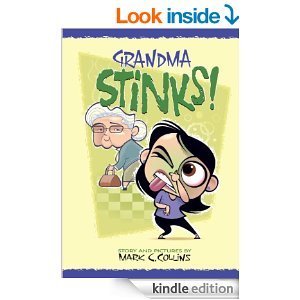
On the cover of the book, we see two cartoon characters, a stereotypical grandma and what seems to be a teenage girl making a dramatic face and holding her nose.
Once inside, it was difficult to ascertain the age of the girl. She seems little when standing by her mother or being hugged by her grandmother, but she manages to carry two large suitcases and a purse. Then again, she plays with dolls and enjoys being read to at bedtime.
Throughout the story, Collins’ character pictures dramatically portray the child’s various expressions of repulsion. The intensity of her reaction does not seem to match the rest of her family. Is the smell that bad, or is she overreacting? As well, the position Grandma holds gives the impression she has flatulence. But, when Grandma and the girl return from the walk, we are given the impression it’s body odour.
The little girl repeatedly shows her ingenuity by attempting ways to diminish the smell: drawing a bath, opening a window, and bringing in an air freshener. I was disappointed that she was unable to have any impact on the problem. Some girls might interpret this message as, you can’t change the situation, you just have to live with it. I confess, I dislike books that subtly give girls the message that the answer is passivity.
At the end of the story, the little girl decides, that because Grandma cherishes her, she can love her back, smell and all. The message of accepting people as they are is a good one, however the idea that the repugnant body odour will continue without any intervention just doesn’t seem reasonable. Because the grandmother is portrayed as generous, affectionate, intelligent, active, and capable, the issue of body odour just doesn’t seem to fit her character.
The tone of the story is mostly over the top silliness. Children will love repeating the phrase, “Grandma Stinks!” Parents would do well to discuss the inappropriateness of that phrase and ensure that their children are mature enough not to repeat it beyond story time. They should discuss reasons why the grandmother might have smelled bad and what the family could have done about it. Surely they would not want the grandmother to be shunned by other people because of her smell.
The family in the story is obviously kind and loving. Throughout the book, the reader assumes that the grandmother is unaware of her stench. However, the ending illustration is puzzling. Grandma winks at the reader and does the hand signal for okay. What are we to make of that?
Children will probably love this book. It will elicit lots of laughs and participation, but I think it needs to be handled with care. An adult should be prepared to discuss the issues raised by “Grandma Stinks!”
I was given a paperback copy of this book in return for publishing a review.


May 2, 2014
Heller, Janet Ruth. How the Moon Regained Her Shape. Illustrated by Ben Hodson. Book Review

What a delight it was to receive a copy of this book for review. The moment I unwrapped the package, I knew it was going to be something exceptional. The blend of a black starry sky with First Nations styled illustrations, possibly Navajo, draw the eye to the bright, detailed cover.
The story begins, “Once the moon was round and full, proud of her gentle light.” When she momentarily blocks the sun she is told, “You ugly scarecrow! People on earth need me to grow their crops. But no one needs you. Get out of my way!” This remark devastates the moon who shrinks down to nothing. A passing comet advises her to go to the mountain where Round Arms lives. Round Arms brings the moon to see an artist, a rabbit family, and dancing women who all express their love for the moon. She regains her sense of worth, and with that the moon expands back to her fullness.
This lovely story is not only a Native American’s legend explaining the phases of the moon, but it is also a testament to the damage cruel remarks may inflict upon another. It shows how the support of friends can make a huge difference to the self-esteem of a bully victim.
Following the story, there are sections on moon observations, Native American’s seasonal names for each full moon, and an excellent page of advice on how to deal with bullies.
There are just enough words on each page to supplement the beautiful illustrations. The story is told simply and effectively. The illustrations are layered, possibly using collage, pastel, and pen. The illustrator, Been Hodgson, won the 2004 Glass Slipper Award from the Society of Children’s Book writers. This book was a finalist for the 2006 Society of Illustrators Original Art. It is easy to see why. He perfectly captures the nastiness of the sun and the melancholy of the moon. The bold colors of the framed pages are reflected in both the clothing of the characters and the background of the Badlands. His work is innovative and vivid.
This book would make a beautiful gift for a child struggling with bullying. As well it would have a place in the classroom in values, science, and Native Americans curriculum. The vocabulary could be understood easily by a primary class (K-3), but the content is also relevant to junior grades (4-6). An exceptional book that I strongly recommend.


May 1, 2014
To Submit a Picture Book in Progress for Critiquing
To Request a Critique of a Picture Book in Progress, please include the following:
Title
Author
Illustrator (Doesn’t have to be illustrated if you are planning on submitting it to a traditional publisher)
Number of Pages
Word count
Suitable age for readers
Your experiences in writing (courses, previous books, etc.) up to 500 words
Copy of the book in mobi or pdf format. Send to b.ferrante at tbaytel dot net
Please put “critique of work in progress request” in the subject line
NOTE You must be a follower to submit.


April 30, 2014
Say, Allen – Emma’s Rug – Book Review
It is rare to find a picture book with such an original story line and such beautiful illustrations, even rarer when they are done by the same person. Allen Say portrays the creative and imaginative Emma beautifully in both word and picture. From a very young age, Emma is a gifted visual artist. The plain white throw rug beside her bed is the source of her inspiration. Many of us have seen patterns in linoleum, ceiling tiles, and clouds that remind us of animals and other things. Emma sees the entire world in the nap of her rug. Tragedy strikes when her mother washes it and all the malleable fuzz is removed. Emma’s muse is gone. She gives up art. In the end, Emma realizes that her entire world is full of hidden pictures, in the trees, the grass, and in the clouds. She resumes her art.
Emma is a child of Japanese descent. In Allen Says’ illustrations, we see children of all sizes and races. The realistic, detailed, exceptionally beautiful pictures make Emma, and her world, come alive. I have previously read Grandfather’s Journey by Allen Say and am pleased that his exceptional quality storytelling and illustrating continues.
Emma’s Rug is sure to stimulate discussion around the source of creative inspiration and the behaviour of artists.
Highly recommended.


April 29, 2014
To Request a Critique of a Picture Book in Progress
Please include the following:
Title
Author
Illustrator (If you have one.)
Number of Pages
Word count
Suitable age for readers
Your experiences in writing (courses, previous books, etc.) up to 500 words
Copy of the book in mobi or pdf format. Send to b.ferrante at tbaytel dot net
Please put “critique of ms” and the title in the subject line
Include a picture if you have one
NOTE You must be a follower to submit.
I do not charge for these critiques but, as a gesture of gratitude, I would appreciate it if you purchased one of my books at http://www.amazon.com/Bonnie-Ferrante/e/B007P7LFYG/ref=sr_ntt_srch_lnk_2?qid=1382025411&sr=8-2 or Amazon.ca.


Method to Request a Picture Book Review
To submit a picture book for review, please include the following:
Title
Author
Illustrator
Number of Pages
Word count
Suitable age for readers
Publisher
Buy link(s)
jpeg of book cover or link to cover graphic
Blurb
Bio – up to 100 words
Copy of the book in mobi or pdf format. NOTE – If you submit a paperback copy, it will be reviewed first. Ask for my postal address.
Send to b.ferrante at tbaytel dot net
Please put “review request” in the subject line



